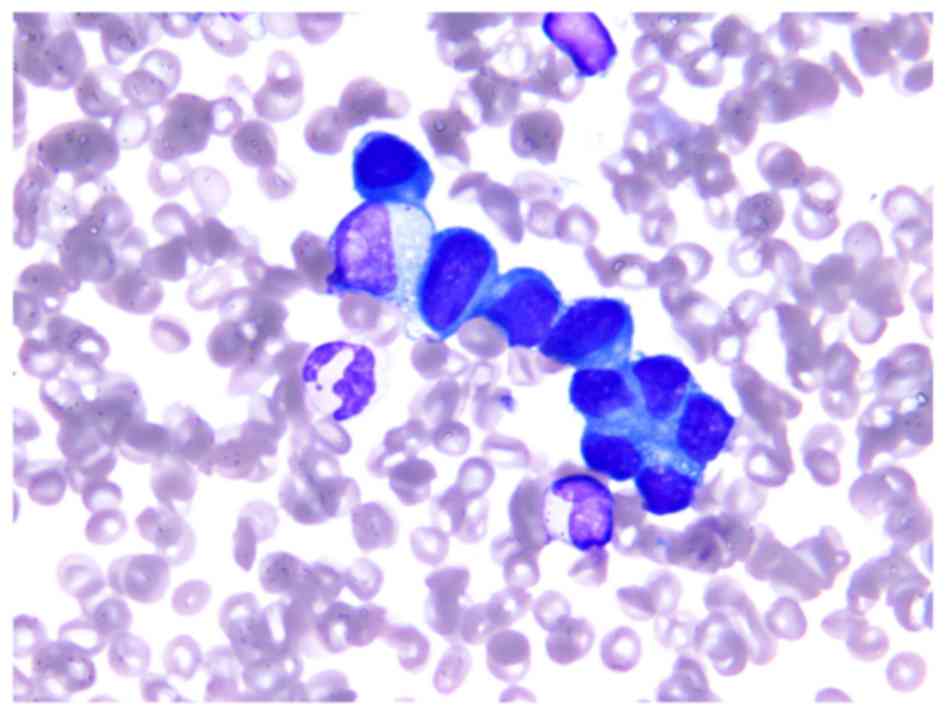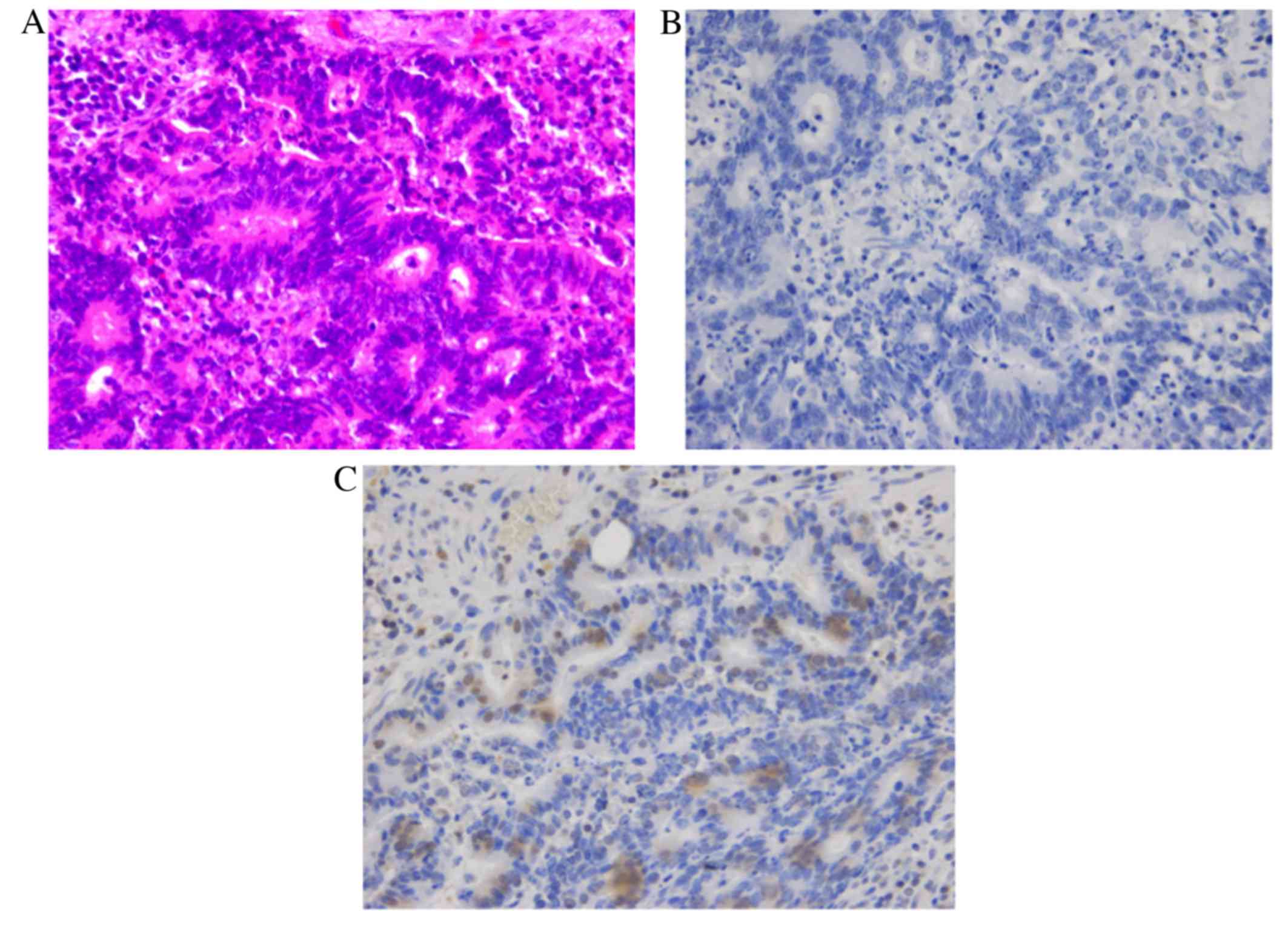|
1
|
Kusumoto H, Haraguchi M, Nozuka Y, Oda Y,
Tsuneyoshi M and Iguchi H: Characteristic features of disseminated
carcinomatosis of the bone marrow due to gastric cancer: The
pathogenesis of bone destruction. Oncol Rep. 16:735–740.
2006.PubMed/NCBI
|
|
2
|
Anner RM and Drewinko B: Frequency and
significance of bone marrow involvement by metastatic solid tumors.
Cancer. 39:1337–1344. 1977. View Article : Google Scholar : PubMed/NCBI
|
|
3
|
Jonsson U and Rundles RW: Tumor metastases
in bone marrow. Blood. 6:16–25. 1951.PubMed/NCBI
|
|
4
|
Yoshioka K, Shimizu H, Yokoo S and Andachi
H: Disseminated carcinomatosis of bone marrow from submucosal
carcinoma in adenoma of the rectum. Intern Med. 31:1056–1059. 1992.
View Article : Google Scholar : PubMed/NCBI
|
|
5
|
Huang WT, Chang KC, Shan YS, Tsao CJ and
Lee JC: Successful initial treatment with weekly 24-hour infusion
of 5-fluorouracil and leucovorin in a rectal cancer patient with
acute disseminated intravascular coagulation.
Hepatogastroenterology. 52:1436–1439. 2005.PubMed/NCBI
|
|
6
|
Misawa R, Kobayashi M, Ito M, Kato M,
Uchikawa Y and Takagi S: Primary colonic signet ring cell carcinoma
presenting carcinocythemia: An autopsy case. Case Rep
Gastroenterol. 2:301–307. 2008. View Article : Google Scholar : PubMed/NCBI
|
|
7
|
van Bunderen CC, de Weger VA and
Griffioen-Keijzer A: Disseminated intravascular coagulation as
clinical manifestation of colorectal cancer: A case report and
review of the literature. Neth J Med. 72:186–189. 2014.PubMed/NCBI
|
|
8
|
Nakashima Y, Takeishi K, Guntani A,
Tsujita E, Yoshinaga K, Matsuyama A, Hamatake M, Maeda T, Tsutsui
S, Matsuda H, et al: Rectal cancer with disseminated carcinomatosis
of the bone marrow: Report of a case. Int Surg. 99:518–522. 2014.
View Article : Google Scholar : PubMed/NCBI
|
|
9
|
Naito M, Yoshida Y, Aisu N, Tanimura S,
Hoshino S, Tanaka T, Nimura S, Tamura K and Yamashita Y: A report
of disseminated carcinomatosis of the bone marrow originating from
transverse colon cancer successfully treated with chemotherapy
using XELOX plus bevacizumab. Case Rep Oncol. 7:426–434. 2014.
View Article : Google Scholar : PubMed/NCBI
|
|
10
|
Lim DH, Lee SI and Park KW: Bone marrow
metastasis of colon cancer as the first site of recurrence: A case
report. Oncol Lett. 8:2672–2674. 2014.PubMed/NCBI
|
|
11
|
Kobayashi N, Maekawa T, Takada M, Tanaka H
and Gonmori H: Criteria for diagnosis of DIC based on the analysis
of clinical and laboratory findings in 345 DIC patients collected
by the research committee on DIC in Japan. Bibl Heamatol. 265–275.
1983.
|
|
12
|
Pasquini E, Gianni L, Aitini E, Nicolini
M, Fattori PP, Cavazzini G, Desiderio F, Monti F, Forghieri ME and
Ravaioli A: Acute disseminated intravascular coagulation syndrome
in cancer patients. Oncology. 52:505–508. 1995. View Article : Google Scholar : PubMed/NCBI
|
|
13
|
Sallah S, Wan JY, Nguyen NP, Hanrahan LR
and Sigounas G: Disseminated intravascular coagulation in solid
tumors: Clinical and pathologic study. Thromb Haemost. 86:828–833.
2001.PubMed/NCBI
|
|
14
|
Levi M and Ten Cate H: Disseminated
intravascular coagulation. N Engl J Med. 341:586–592. 1999.
View Article : Google Scholar : PubMed/NCBI
|
|
15
|
Levi M: Disseminated intravascular
coagulation in cancer patients. Best Pract Res Clin Haematol.
22:129–136. 2009. View Article : Google Scholar : PubMed/NCBI
|
|
16
|
Esmon CT: Possible involvement of
cytokines in diffuse intravascular coagulation and thrombosis.
Baillieres Best Pract Res Clin Haematol. 12:343–359. 1999.
View Article : Google Scholar : PubMed/NCBI
|
|
17
|
Koopman M, Venderbosch S, Nagtegaal ID,
van Krieken JH and Punt CJ: A review on the use of molecular
markers of cytotoxic therapy for colorectal cancer, what have we
learned? Eur J Cancer. 45:1935–1949. 2009. View Article : Google Scholar : PubMed/NCBI
|
|
18
|
Kumamoto K, Kuwabara K, Tajima Y, Amano K,
Hatano S, Ohsawa T, Okada N, Ishibashi K, Haga N and Ishida H:
Thymidylate synthase and thymidine phosphorylase mRNA expression in
primary lesions using laser capture microdissection is useful for
prediction of the efficacy of FOLFOX treatment in colorectal cancer
patients with liver metastasis. Oncol Lett. 3:983–989.
2012.PubMed/NCBI
|
|
19
|
Altaha R, Liang X, Yu JJ and Reed E:
Excision repair cross complementing-group 1: Gene expression and
platinum resistance. Int J Mol Med. 14:959–970. 2004.PubMed/NCBI
|
|
20
|
Shirota Y, Stoehlmacher J, Brabender J,
Xiong YP, Uetake H, Danenberg KD, Groshen S, Tsao-Wei DD, Danenberg
PV and Lenz HJ: ERCC1 and thymidylate synthase mRNA levels predict
survival for colorectal cancer patients receiving combination
oxaliplatin and fluorouracil chemotherapy. J Clin Oncol.
19:4298–4304. 2001. View Article : Google Scholar : PubMed/NCBI
|
|
21
|
Arienti C, Tesei A, Verdecchia GM,
Framarini M, Virzi S, Grassi A, Scarpi E, Turci L, Silvestrini R,
Amadori D and Zoli W: Role of conventional chemosensitivity test
and tissue biomarker expression in predicting response to treatment
of peritoneal carcinomatosis from colon cancer. Clin Colorectal
Cancer. 12:122–127. 2013. View Article : Google Scholar : PubMed/NCBI
|
|
22
|
Blake P, Delicata R, Cross N, Sturgeon G
and Hargest R: Large bowel obstruction due to colorectal carcinoma
can be safely treated by colonic stent insertion-case series from a
UK district general hospital. Colorectal Dis. 14:1489–1492. 2012.
View Article : Google Scholar : PubMed/NCBI
|
|
23
|
Lacey DL, Timms E, Tan HL, Kelley ML,
Dunstan CR, Burgess T, Elliott R, Colombero A, Elliott G, Scully S,
et al: Osteoprotegerin ligand is a cytokine that regulates
osteoclast differentiation and activation. Cell. 93:165–176. 1998.
View Article : Google Scholar : PubMed/NCBI
|
|
24
|
Stopeck AT, Lipton A, Body JJ, Steger GG,
Tonkin K, de Boer RH, Lichinitser M, Fujiwara Y, Yardley DA,
Viniegra M, et al: Denosumab compared with zoledronic acid for the
treatment of bone metastases in patients with advanced breast
cancer: A randomized, double-blind study. J Clin Oncol:.
28:5132–5139. 2010. View Article : Google Scholar : PubMed/NCBI
|
|
25
|
Fizazi K, Lipton A, Mariette X, Body JJ,
Rahim Y, Gralow JR, Gao G, Wu L, Sohn W and Jun S: Randomized phase
II trial of denosumab in patients with bone metastases from
prostate cancer, breast cancer, or other neoplasms after
intravenous bisphosphonates. J Clin Oncol. 27:1564–1571. 2009.
View Article : Google Scholar : PubMed/NCBI
|
|
26
|
Smith MR, Egerdie B, Hernández Toriz N,
Feldman R, Tammela TL, Saad F, Heracek J, Szwedowski M, Ke C, Kupic
A, et al: Denosumab in men receiving androgen-deprivation therapy
for prostate cacner. N Engl J Med. 361:745–755. 2009. View Article : Google Scholar : PubMed/NCBI
|
|
27
|
Misso G, Porru M, Stoppacciaro A,
Castellano M, de Cicco F, Leonetti C, Santini D and Caraglia M:
Evaluation of the in vitro and in vivo antiangiogenic effects of
denosumab and zoledronic acid. Cancer Biol Ther. 13:1491–1500.
2012. View Article : Google Scholar : PubMed/NCBI
|
|
28
|
Henry DH, Costa L, Goldwasser F, Hirsh V,
Hungria V, Prausova J, Scagliotti GV, Sleeboom H, Spencer A,
Vadhan-Raj S, et al: Randomized, double-blind study of denosumab
versus zoledronic acid in the treatment of bone metastases in
patients with advanced cancer (excluding breast and prostate
cancer) or multiple myeloma. J Clin Oncol. 29:1125–1132. 2011.
View Article : Google Scholar : PubMed/NCBI
|
|
29
|
Scagliotti GV, Hirsh V, Siena S, Henry DH,
Woll PJ, Manegold C, Solal-Celigny P, Rodriguez G, Krzakowski M,
Mehta ND, et al: Overall survival improvement in patients with lung
cancer and bone metastases treated with denosumab versus zoledronic
acid: Subgroup analysis from a randomized phase 3 study. J Thorac
Oncol. 7:1823–1829. 2012. View Article : Google Scholar : PubMed/NCBI
|
|
30
|
Fizazi K, Carducci M, Smith M, Damião R,
Brown J, Karsh L, Milecki P, Shore N, Rader M, Wang H, et al:
Denosumab versus zoledronic acid for treatment of bone metastases
in men with castration-resistant prostate cancer: A randomised,
double-blind study. Lancet. 377:813–822. 2011. View Article : Google Scholar : PubMed/NCBI
|












